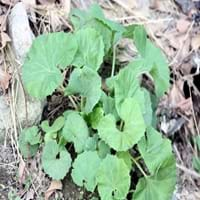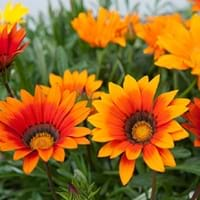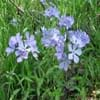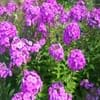Life Span
Perennial
Annual
Type
Herbaceous Perennial
Flowering Plants, Ornamental Plants, Shrub
Origin
China, Japan, Korea
Australia, Mediterranean, New Zealand, United States
Types
Not Available
Treasureflower, Terracotta Gazania
Number of Varieties
Not Available
Habitat
Lake Sides, River side
Lower slopes, meadows
USDA Hardiness Zone
5-9
9-11
Sunset Zone
2a, 2b, 3a, 3b, 4, 5, 6, 7, 8, 9, 10, 14, 15, 16, 17, 18, 19, 20, 21, 22, 23, 24
4, 5, 6, 7
Habit
Clump-Forming
Spreading
Flower Color
Light Yellow, Ivory
Orange, Orange Red, Yellow
Flower Color Modifier
Bicolor
Bicolor
Fruit Color
Not Available
Not Available
Leaf Color in Spring
Green
Green
Leaf Color in Summer
Green
Green
Leaf Color in Fall
Green
Green
Leaf Color in Winter
Not Available
Green
Leaf Shape
Orbiculate
Lanceolate
Plant Season
Spring, Summer, Fall
Spring, Summer
Sunlight
Partial shade, Full Shade
Full Sun, Partial Sun
Type of Soil
Clay, Loam, Sand
Loam, Sand
The pH of Soil
Acidic, Neutral, Alkaline
Acidic
Soil Drainage
Poorly Drained
Well drained
Bloom Time
Early Spring, Late Winter
Early Spring, Spring, Late Spring
Tolerances
Wet Site
Not Available
Where to Plant?
Container, Ground
Container, Ground
How to Plant?
From Rhizomes
Seedlings, Stem Cutting
Plant Maintenance
Medium
Medium
Watering Requirements
Keep ground moist, Requires consistently moist soil
Do not water the foliage, Needs very little water
In Summer
Lots of watering
Moderate
In Spring
Moderate
Moderate
In Winter
Average Water
Average Water
Soil pH
Acidic, Neutral, Alkaline
Acidic
Soil Type
Clay, Loam, Sand
Loam, Sand
Soil Drainage Capacity
Poorly Drained
Well drained
Sun Exposure
Partial shade, Full Shade
Full Sun, Partial Sun
Pruning
Cut or pinch the stems, Remove damaged leaves, Remove dead branches, Remove dead leaves
Prune if you want to improve plant shape, Remove dead or diseased plant parts
Fertilizers
All-Purpose Liquid Fertilizer, Requires high amount of nitrogen
All-Purpose Liquid Fertilizer, organic fertlizers, slow-release fertilizers
Pests and Diseases
Red blotch
Red blotch
Plant Tolerance
Drought, Drought and Wet Site
Heat Tolerance, Sun
Flower Petal Number
Not Available
Single
Foliage Texture
Bold
Fine
Foliage Sheen
Glossy
Glossy
Attracts
Not Available
Butterflies
Allergy
Not Available
Abdominal distension, flushing of face, Tight chest
Aesthetic Uses
Beautification
Bouquets, Cottage Garden, Showy Purposes
Beauty Benefits
Not Available
Anti-ageing, Beautiful Skin, Skin cleanser
Environmental Uses
Air purification
Fixes Nitrogen, Forms dense stands
Medicinal Uses
Antiasthamatic, Expectorant, Miscellany
anti-inflammatory, Rheumatism
Part of Plant Used
Flowers, Stem
Leaves
Other Uses
Not Available
Florist trade and landscaping, Showy Purposes, Used for fragrance
Used As Indoor Plant
No
No
Used As Outdoor Plant
Yes
Yes
Garden Design
Bog Garden, Container, Water Gardens
Container, Hanging Basket, Mixed Border, Rock Garden / Wall, Wildflower
Botanical Name
PETASITES japonicus 'Argentea'
PHLOX nivalis
Common Name
Giant Butterbur, Japanese Butterbur, Variegated Butterbur
Trailing Phlox
In Hindi
Japanese Butterbur
Gazania
In German
japanische Pestwurz
Gazania
In French
Japanese Butterbur
Gazania
In Spanish
petasita japonesa
Gazania
In Greek
Japanese Butterbur
Gazania
In Portuguese
Carrapicho japonês
Gazania
In Polish
japoński Lepiężnik
Gazania
In Latin
Japanese Butterbur
Gazania
Phylum
Tracheophyta
Magnoliophyta
Class
Magnoliopsida
Magnoliopsida
Order
Asterales
Asterales
Family
Asteraceae
Asteraceae
Clade
Angiosperms, Asterids, Eudicots
Angiosperms, Asterids, Eudicots
Tribe
Not Available
Arctotideae
Subfamily
Not Available
Cichorioideae
Number of Species
Not Available
Season and Care of Japanese Butterbur and Gazania
Season and care of Japanese Butterbur and Gazania is important to know. While considering everything about Japanese Butterbur and Gazania Care, growing season is an essential factor. Japanese Butterbur season is Spring, Summer and Fall and Gazania season is Spring, Summer and Fall. The type of soil for Japanese Butterbur is Clay, Loam, Sand and for Gazania is Loam, Sand while the PH of soil for Japanese Butterbur is Acidic, Neutral, Alkaline and for Gazania is Acidic.
Japanese Butterbur and Gazania Physical Information
Japanese Butterbur and Gazania physical information is very important for comparison. Japanese Butterbur height is 60.00 cm and width 120.00 cm whereas Gazania height is 15.20 cm and width 30.00 cm. The color specification of Japanese Butterbur and Gazania are as follows:
Japanese Butterbur flower color: Light Yellow and Ivory
Japanese Butterbur leaf color: Green
Gazania flower color: Orange, Orange Red and Yellow
- Gazania leaf color: Green
Care of Japanese Butterbur and Gazania
Care of Japanese Butterbur and Gazania include pruning, fertilizers, watering etc. Japanese Butterbur pruning is done Cut or pinch the stems, Remove damaged leaves, Remove dead branches and Remove dead leaves and Gazania pruning is done Prune if you want to improve plant shape and Remove dead or diseased plant parts. In summer Japanese Butterbur needs Lots of watering and in winter, it needs Average Water. Whereas, in summer Gazania needs Moderate and in winter, it needs Average Water.





